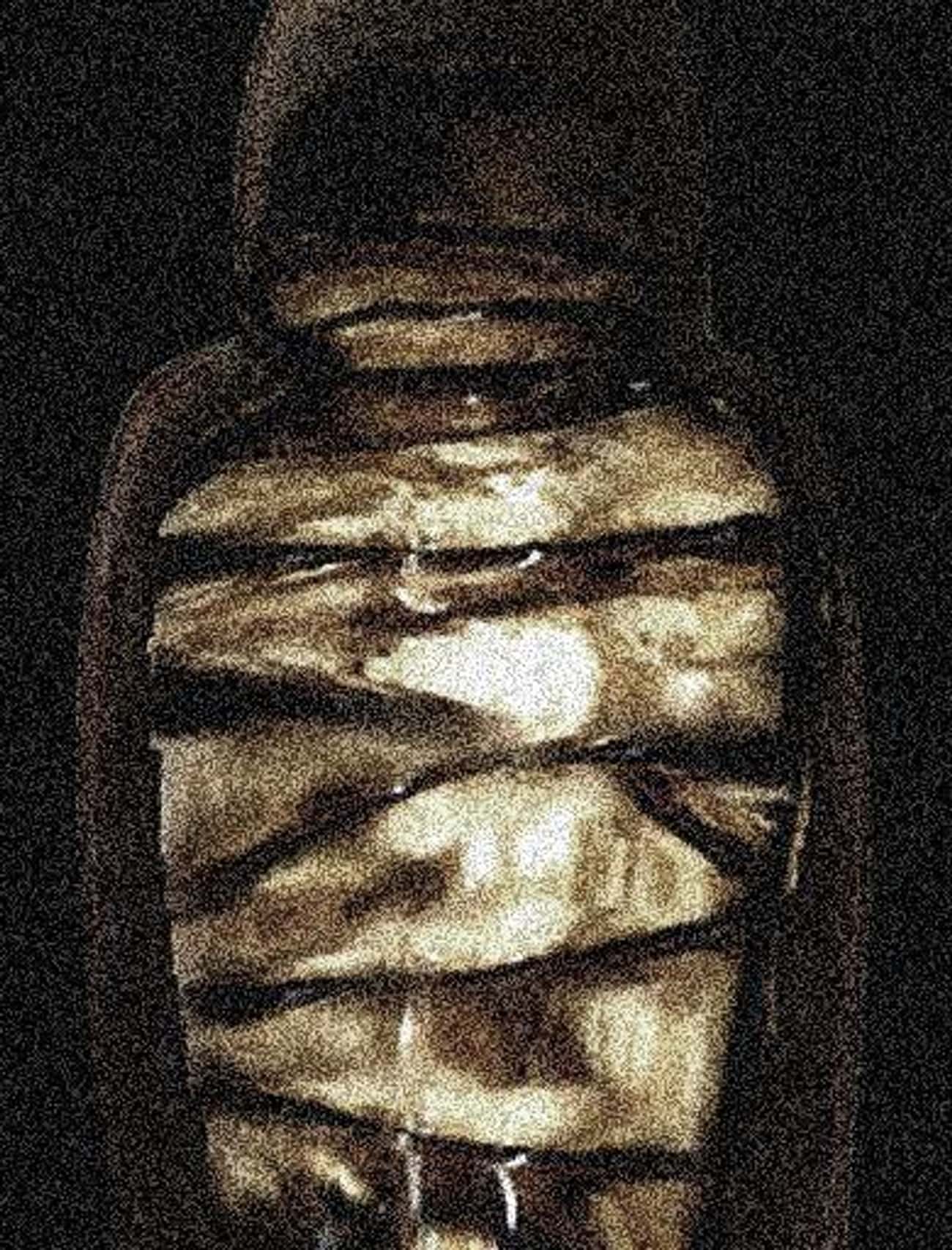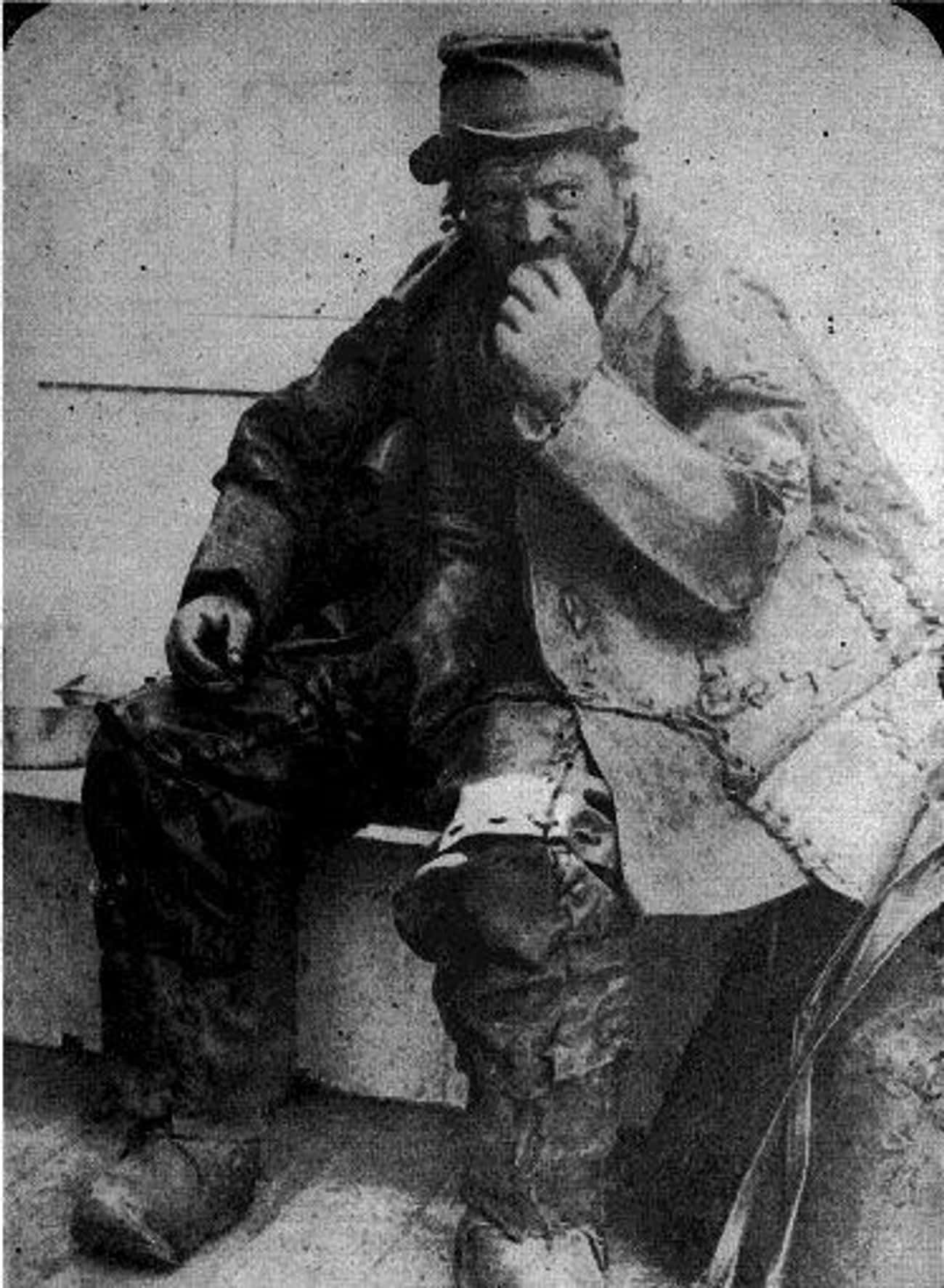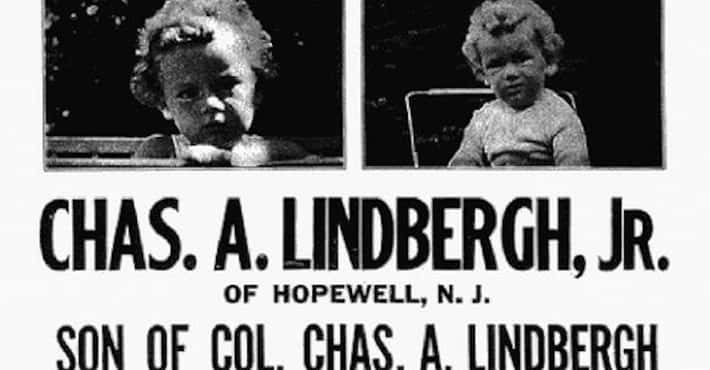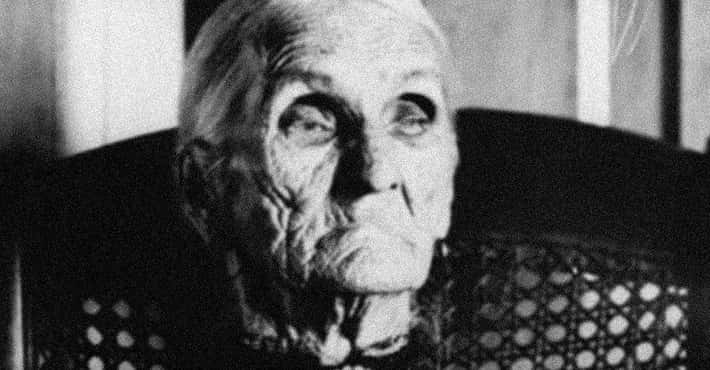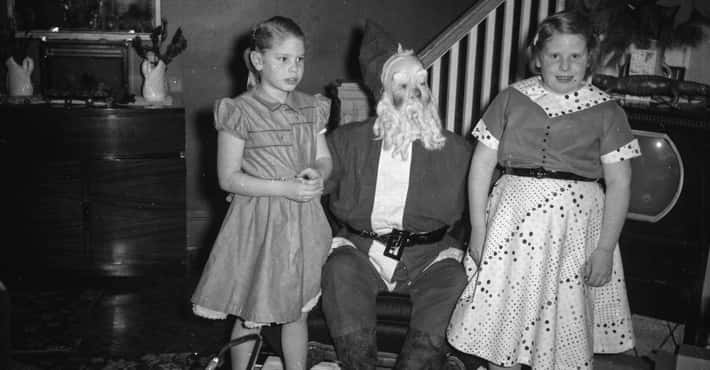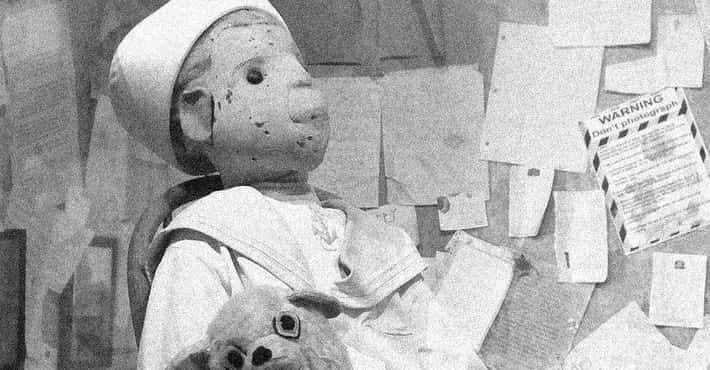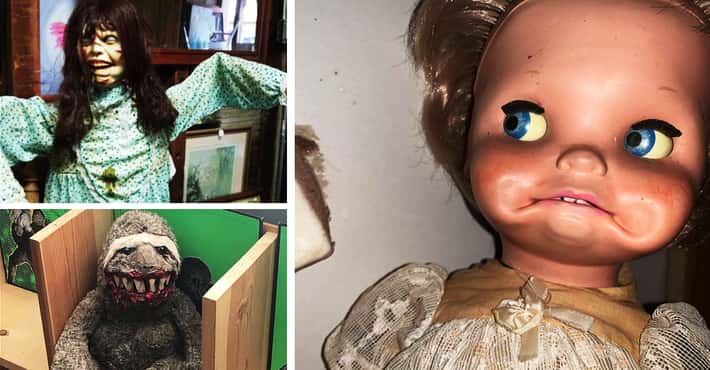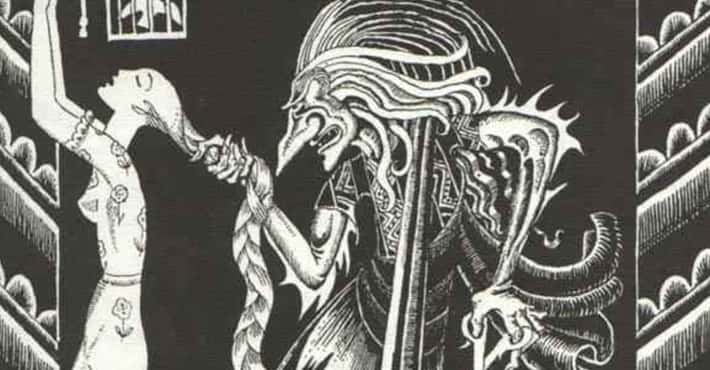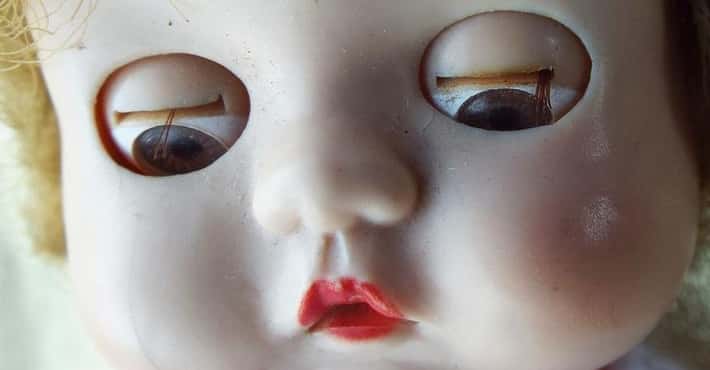Creepy Things From History We Can't Get Out Of Our Heads
Vote up the creepy history items that will stay with you for longer than you want them to.
Some historical moments just can't be erased from the brain. Disturbing mysteries or true stories with grotesque or terrifying details can swim around in your conscious memory day and night.
From humanity's surprising obsession with mummy cannibalism, to mysterious archaeological findings with unsettling explanations, the creepy things from history on this list will stay with you, probably for longer than you'd like.
- Photo: Photograph Curator / Flickr / Public domain
Six months after Pearl Harbor, the salvage crews who raised the remains of the USS West Virginia from the ocean found three cadavers in an airtight storeroom, along with empty emergency food rations, used batteries, and a calendar marked with 16 red X's from December 7-23. Once the cadavers were found, fellow service members and friends didn't have the heart to tell their families how they perished.
Ronald Endicott, Clifford Olds, and Louis “Buddy” Costin were trapped inside the ship when it sank. On December 7, most service members thought the banging noises they heard coming from the West Virginia were pieces of loose rigging hitting the side of the ship. As the other surrounding noises grew fainter, they realized men were still alive in the storeroom.
Because the water around the battleship was covered in oil, rescuers couldn't use a torch to create an escape. Besides, cutting any type of hole in the vessel would immediately cause the whole room to flood. Marines and sailors dreaded having to stand duty anywhere within earshot of the wreckage, knowing they would hear the cries of their friends stuck on board with no way to help them.
The fates of Endicott, Olds, and Costin remained a well-kept secret for 54 years. All three of their headstones still claim they perished on December 7, 1941.
- Photo: Dropd / Wikimedia Commons / CC-BY-SA 3.0
Madame Delphine LaLaurie, a New Orleans socialite in the 1830s, often threw parties in her Royal Street home, where several enslaved people served her guests and attended to her needs. While she outwardly treated the enslaved people politely, she hid a horrific secret behind closed doors. On April 10, 1834, a house fire revealed that she had been tormenting and slaying them.
The year before, LaLaurie had been ordered to sell the enslaved people after she chased a small enslaved girl over the mansion's roof to her death. She then sold them to loyal friends and family members who helped her sneak them back into the estate.
When firefighters arrived at the scene the night of April 10, they found an enslaved woman chained up in the kitchen, unable to escape, while LaLaurie was frantically trying to save her furniture from the flames. The 70-year-old Black enslaved woman told officials she started the fire to escape from the pain she was enduring, then directed them to the attic. There, firefighters found seven malnourished enslaved people wearing iron-spiked collars. Some had gaping holes in their heads, some were weighed down by heavy chains around their feet, and all were incredibly thin and covered in scars.
Although her reputation was ruined, LaLaurie was never charged for her offenses.
- Photo: Unknown / Wikimedia Commons / Public domain32,675 VOTES
Béla Kiss Was A Hungarian Serial Killer and Pickler
To onlookers, he was a handsome gentleman from Budapest who ran a successful tin business and threw elaborate parties. But behind closed doors, the eligible bachelor killed and mutilated at least 23 women before pickling their bodies and storing them in steel drums on his property.
In 1903, Béla Kiss began placing ads in newspapers under the alias “Hoffman,” claiming to be a lonely widower looking for a companion. When a woman responded, he would convince her to give him all her money and assets before luring her into his home, where he would strangle her with a rope or his bare hands. He drained each woman's blood by making an incision in her neck, then placed her body in a steel barrel filled with methanol.
Kiss stored the drums, filled with the pickled women's remains, on his property, eventually arousing suspicion from neighbors. Still, most people assumed he was using the drums to store gasoline.
The women's remains were undetected on his property until he was drafted into the Austro-Hungarian Army in 1914. After hearing rumors that Kiss had been killed in action, his landlord went through his belongings to make room for a new tenant. When he opened the first drum, the landlord was overcome by the smell of a decomposing corpse. He called the constable, who opened the remaining drums to find 24 pickled cadavers.
Kiss never returned home, and was never seen or heard from again. His fate, along with the names of many of his victims, remains unknown.
- Photo: Théodore Géricault / Wikimedia Commons / Public domain42,295 VOTES
An Incompetent French Captain Wrecked His Ship Before Leaving Its Passengers To Perish At Sea
On July 2, 1816, a French naval vessel, the Medusa, got stuck on a sandbar off the coast of Africa. The incident immediately caused a scandal because the incompetent captain, Hugues Duroy de Chaumareys, had earned his position due to political connections. After three days of trying to redirect the ship, the crew decided to abandon the vessel.
More than 400 people were aboard, but the lifeboats could hold only around 250. De Chaumareys chose to save himself and his senior officers, leaving 146 ship passengers to fend for themselves on a hastily and poorly constructed raft.
The unfortunate raft passengers spent a grueling 13 days at sea, with only a bag of biscuits, some water, and a few casks of wine to survive. Out of desperation and growing hostility among the group, many were thrown overboard in fights, or slain and eaten by the remaining people afloat. By the time they were rescued, only 15 men had survived.
- Photo: Sachem31 / Wikimedia Commons / Public domain
Though people recognize honey as a tasty treat that can heal everything from cuts and scrapes to seasonal allergies, its use for mummification often goes overlooked. The ancient Assyrians embalmed the deceased with honey, and Alexander the Great was reportedly submerged in a coffin full of the amber liquid.
But in 16th-century China, people combined honey's use as a food and embalming substance: They ate mummies covered in honey to cure all types of ailments. The mummification process started while the person was still alive.
The process, mellification, gave the elderly population an opportunity to donate their cadavers to science. As they neared the end of their lives, they stopped eating or drinking anything but honey. Eventually, their insides basically turned into the substance; they would sweat, defecate, and bleed honey until they perished. Then, their cadavers were placed in coffins filled with honey and left to marinate for about a century. Once the body had turned into a sugary blob of candy, it was sold by merchants as a healing tonic. Patients could use it topically to treat scrapes and broken bones or ingest it to heal internal ailments.
Although no concrete evidence exists that patients used the mellified human remains as medicine, corpse medicine was common at the time, and archaeological dig sites suggest that honey entombment was a part of cultural practice.
- Photo: Vibha C Kashyap / Wikimedia Commons / CC BY-SA 4.062,036 VOTES
The Baby From The Little Albert Experiment May Have Met A Tragic End
In 1920, behaviorist John Watson set out to expand psychologist Ivan Pavlov's study of conditioning in dogs, deciding he should test the theory on humans. In the famous controversial study, Watson paid the mother of a 9-month-old baby $1 to purposefully create a fear-based response in the child.
After placing the baby boy, nicknamed “Little Albert,” in a room, he introduced several objects to see how the baby would respond. In the beginning, Little Albert was unafraid of the white rats, monkeys, masks, and burning newspapers placed in the room with him. However, his reaction dramatically changed when Watson started making startlingly loud noises every time the rat entered the room. Eventually, Little Albert correlated the scary noise with the rat and began fearfully crying at the mere sight of the animal.
The little boy and his mother moved away before Watson and his colleagues had the opportunity to decondition him. Because the psychologist referred to the child only by his nickname in notes, the experiment's lasting results and the child's welfare remained a mystery for almost a century. While some considered the experiment entirely unethical from the beginning, Watson's work fell under even more scrutiny once the mystery of the child's identity was solved.
In 2010, Appalachian State University's Hall P. Beck, along with his colleagues and students, spent seven years uncovering historical documents and using facial recognition technology to identify the child and reveal his tragic fate. They believed the little boy's name was Douglas Merritte, and he died from hydrocephalus (a build-up of fluid in his brain) when he was 6, a condition he had since birth. In 2012, Beck and Alan J. Fridlund revealed an even more disturbing aspect of the tragedy when they presented substantial evidence that Watson knew of the baby's condition the entire time he was conditioning his fearful responses.
Another possible “Little Albert” was identified in 2014, however. Researchers posited that the little boy was Albert Barger. Born on the same day as Merritte, Barger had characteristics that resembled those of “Little Albert," his mother worked at the same hospital as Merritte's mother, and he also grew up to fear furry animals. His name (which was actually his middle name but the one he went by throughout his life) also supports claims that Barger was “Little Albert.”
- Photo: Pieter Frits / Wikimedia Commons / Public domain
Johan de Witt, the son of an influential Dutch aristocrat, became ruler of Holland during the “Dutch Golden Age” in 1653. His subjects loved de Witt, and he was reelected for three consecutive terms. Although he successfully maintained peace with other European nations, his extreme dislike of the Orange monarchy, a branch consisting of Europe's social elite, caused tension among the nation's political sects. De Witt's hatred was so intense that he refused to appoint the Prince of Orange to a political position.
The fragile peaceful equilibrium de Witt created between the Dutch and neighboring countries came to an abrupt halt in 1672 when Louis XIV declared war on the Dutch Republic, with England joining the French. Though the Dutch navy was prepared to fight, de Witt had overlooked the Dutch army. This fateful oversight caused upheaval among the Dutch people as France repeatedly besieged their homeland.
The Dutch ultimately blamed de Witt and his inattention to the Dutch inland army for the catastrophic losses. Dutch law enforcement detained de Witt's brother, Cornelis, after charging him with treason and conspiracy against William III - the Prince of Orange. In August 1672, Johan de Witt resigned before he left to visit his brother in prison. Unfortunately for the once-beloved ruler, a lynch mob waited for him at the Gevangenpoort prison.
With no guards present to stop them, the mob ripped de Witt and his brother to pieces before hanging their cadavers by their feet in the center of town. Then, group members cut up what remained of their mangled cadavers, selling off the pieces of flesh, meat, and bones for 10 sous apiece. Though it can't be confirmed, it's rumored that the Dutch people ate Johan de Witt's body parts after his demise. William III never pressed charges.
- Photo: James F. Rodgers / Wikimedia Commons / Public domain81,815 VOTES
The Mysterious Leatherman Dressed In All Leather, Walked Hundreds Of Miles, And Slept In Caves
In the 1800s, a mysterious person known as the “Leatherman" consistently walked a 365-mile circle for no apparent reason. Though no one ever learned his name, where he came from, or why he chose to make the trek, he became a beloved local celebrity.
The Leatherman wore a boot suit, an outfit constructed from old leather boots and ties that weighed over 60 pounds, through all weather and seasons. He slept in caves and was so consistent in his timing that locals could tell time based on his location. The Leatherman completed the circuit between the Hudson and Connecticut rivers every 34 days, walking through 40 small towns along the way.
Though he never spoke beyond a few grunts in English or French, adults and children in the town looked forward to his visits. When the Leatherman stopped by a home, it was considered an honor, and schoolchildren stayed on their best behavior in hopes of being chosen to bring the Leatherman food when he passed their campuses.
After he perished, so many people visited the Leatherman's roadside grave that the local historical society decided to move it farther inland to avoid potential accidents. When the body was exhumed for reburial in 2011, many thought DNA testing might help solve the mystery of who he was.
However, those hopes were dashed when they opened the casket to find that the remains were missing. Now, the Leatherman is shrouded in even more mystery: No one knows who he was or where he is.
- Photo: Yinan Chen / Wikimedia Commons / Public domain91,288 VOTES
When The Earth Had More Oxygen, It Led To Giant Bugs
During the prehistoric ages, dragonflies were the size of seagulls. While scientists used to believe this occurred because the enormous insects thrived on the higher amounts of oxygen in the atmosphere at the time, recent studies present an alternative answer. Some experts now argue that too much oxygen can be a bad thing, and insect larvae had to increase in size to avoid oxygen poisoning.
Around the same time frame that giant dragonflies flew across the skies, the swampland forestation levels led to a 30% increase in oxygen levels, about 50% more than what we breathe daily now. According to experts, this atmospheric phenomenon during the Carboniferous period also provided a way for the giant insects and bugs to evolve once the levels of oxygen in the atmosphere began to decrease. As the avian population evolved, birds became the most dominant animals in the skies.
If giant dragonflies don't bother you, consider this: 9-foot millipedes, 8-foot scorpions, and long-legged cockroaches that could turn their heads to spot their prey also existed.
- 101,122 VOTES
A 7,000-Year-Old Pit Possibly Used For Cannibalistic Rituals Was Discovered In Germany
In 1996, archaeologists uncovered a mass grave in Herxheim, Germany, of over 500 men, women, and children whose muscles, tissues, and organs were cut from their cadavers postmortem. After examining the bones, experts believe that all of these people were healthy at the time of their passing. They disagree on whether or not the remains display signs of human butchering practices or reburial rituals.
Bruno Boulestin of the University of Bordeaux in France believes the bones belong to enslaved people, war prisoners, and others who were subjected to a cannibalistic ritual 7,000 years ago. The remains show signs of butchering, where meat was stripped from the bones and brains, and facial tissues were removed from the skulls.
Other experts remain skeptical about why the meat was stripped from the bones of the dead. Jörg Orschiedt of the University of Leipzig and Miriam Haidle of the Senckenberg Research Institute and Natural History Museum maintain that the missing jawbones on the cadavers indicate a reburial scenario, much like those performed in ancient Egypt.
- Photo: Anonymous / Wikimedia Commons / Public domain
China's first emperor, Qin Shi Huang, was a highly ambitious ruler. By the time he passed in 210 BCE, he had successfully united China's six quarreling states to create a peaceful, unified nation. His interment site is famously surrounded by the Terracotta Army, a collection of over 8,000 ceramic soldiers and horses meant to protect Qin Shi Huang in the afterlife. Ironically, he never intended to end up in this massive mausoleum. The emperor spent his short 39 years searching villages near and far to find an elixir for immortality. Unfortunately, this very quest most likely ended his life.
When over 36,000 slips of bamboo covered in ancient calligraphy surfaced in 2002, researcher Chunlong Zhang set to work deciphering them. Zhang found 48 medicine-related slips, confirming that the emperor placed a decree on the nation in pursuit of a potion that would allow him to live forever. Some slips even revealed the villager's responses to the request, offering special elixirs or expressing regret that they hadn't found a solution.
One of the substances he regularly ingested was cinnabar, also known as mercury sulfide. Experts attributed Qin Shi Huang's cinnabar habit to his belief that the substance would help him live for eternity. Instead, he was inflicting himself with mercury poisoning.






